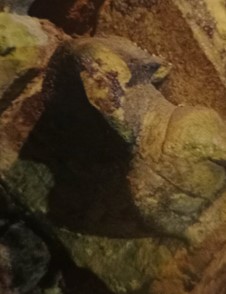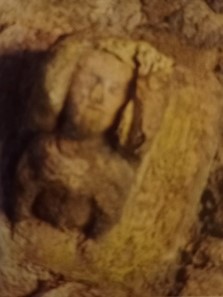Was Dundonald Castle one of the Most Romantic Places in Medieval Scotland?

Dundonald Castle and Visitor Centre sadly won’t be open this year for the usual treat of St Valentine’s Day empire biscuits, chocolate cake with hot chocolate or a love heart latte in the café due to the Covid-19 closure regulations presently in place. However, we didn’t want to let this day pass without mention, and this year, on our 650th Anniversary, we’ve decided to explore the history St Valentine’s Day itself, and how it might have been celebrated when King Robert II was staying here.
We do know that St Valentine’s day has its origins in the Roman festival of ‘Lupercalia’. This festival was designed to celebrate the coming of spring and, with that, included fertility rites associated with the god Faunus and the pairing off of women with men by a lottery. It was conducted annually on February 15th under the superintendence of a cohort of priests called Luperci, and even though origins of the festival are obscure, the name is likely to be derivation of lupus -Latin for wolf. This could be connected with the ancient deity who protected herds from wolves and most famously with the legendary she-wolf who nursed twins Romulus and Remus.
Romans brought their festivals with them to Britain, although, Christian priests attempted to replace Lupercalia celebrations when at the end of the 5th century Pope Gelasius I (Pope from 492 to 496) made it a feast day to honour St. Valentine instead.
Valentine could have been one of two men, both reputedly named ‘Valentine’ – one who was martyred by the Romans for his Christian beliefs the eve before Lupercalia, on the 14th February, and the other whose legend tells that he defied the emperor’s orders by secretly marrying couples to spare the husbands from going away to war and thus somewhat depleting the Roman Army’s fighting force.
However despite the efforts of the priests, the ‘lottery’ system survived for quite some time when in 1725 Henry Bourne (1696-1733) noted in his book ‘Antiquitates Vulgares’ (a documentation of common people’s behaviours and ceremonies at the time):
“It is a ceremony never omitted among the vulgar; to draw lots which they term ‘Valentines’. The names of select number of one sex are by an equal number of the other put into some vessel and after that everyone draws a name which for the present is called their Valentine. It is also look’d upon as a good omen of their being man and wife.”
So, it seems that this may have been the origins of there being something of an element of chance surrounding St Valentine’s Day customs. Common belief was that the first man a woman saw on the day must be her Valentine, whether she liked him or not(!). In an attempt to influence fate further, some girls ate boiled eggs, shell and all, having first replaced the yolk with salt. Others pinned bay leaves to their pillows (in the language of flowers a bay plant means ‘only death will part us’) to help illicit a good match. Unmarried women said a prayer the night before which is likely to have evolved to become the St Valentine’s Day poetry which we find today:
Sweet Guardian angels, let me have
What I most earnestly do crave
A Valentine endowed with love
That will both kind and constant prove.
So, what of Dundonald Castle – would St Valentine’s Day have been celebrated here?
We know that the feast of St Valentine has been associated with love since the Middle Ages, when Valentine was one of many saints honoured in the Christian calendar, alongside major religious festivals, such as Christmas, Easter, and Pentecost. In medieval times people lived their lives according to the liturgical – or ceremonial – year.
Robert II would have had a small chapel in, or near, Dundonald Castle for which he would have made regular Christian observance including the Christian festivals, which may have included St Valentine’s Day. We do know that St Valentine’s Day began to be celebrated as a day of romance from about the middle of the 14th century so this makes the theory that he did more likely. Inside the tower house, which he had rebuilt at the start of his reign in 1371, there is not only one but two great vaulted feasting halls, built one above the other. The Lower (Laigh) Hall features what was possibly a specially designated mistrals gallery with its own staircase and latrine on the north side. From this, we can envisage Robert and his courtiers enjoying many a fine feast of local Ayrshire game and medieval music here, and so we might also imagine that Robert and Euphemia could have held the feast of St Valentine’s Day at the castle, in one of their grand halls.
Of course, none of this actually tells us if he was inclined to celebrate St Valentine’s Day, nor indeed had a romantic bone in his body, but the most exciting and recognised nod towards any theory of Robert II”s celebration of love and romance, can still to be found inside the Lower Hall of the castle. Set inside the top curve of the huge arched stone window at the south end of the hall, there are two life-size sculpted stone heads of a man and a woman; these are thought to be effigies of King Robert II and his wife Queen Euphemia, which face towards each other. Given that most medieval art is based on symbolism, we think that these sculptures may well have been placed there within the arch which was designed to point upwards towards the heavens, to depict the symbol of their great love. They are set high above the hall, looking down on the people below to show their status as King and Queen as being high above all the rest and yet, perhaps might also mean they believed that their love was the highest in the land and closest to God.



Most remarkably, as you can see from the photos here they are still in relatively recognisable form even though they’ve been here for 650 years! This shows us something of the attention to detail given to their crafting, as well as the quality with which they were created. Sadly, we don’t know who made them, but might we consider that they were created as a romantic gift to Euphemia from Robert to express his devotion, and perhaps they were revealed to her on St Valentine’s Day itself! This is not so far-fetched an idea when we consider too that Robert was a great knight of Scotland in his own right and in the Middle Ages, one regarded as a great knight was not simply a great warrior, for he was also expected to be kind, courteous, generous and devoted to his lady: qualities that combined to produce perfect chivalry.
Gift-giving on St Valentine’s Day is meant to have come from the days of chivalry when a knight would wear a token of his lady-love, i.e. her glove or scarf, which she had presented to him in order to show her affections of support to wear when he rode to battle or to tournament. Given this, is it even possible that it was Euphemia who had these sculptures made as a gift to Robert? That, we will probably never know!
The Castle has been host to delightful wedding ceremonies in recent years, so we like to imagine the bride and groom are in good company with the days gone by as they make their vows here. Of course, we can’t know if Robert and Euphemia openly showed their affections on St Valentine’s Day, but the views they had from the top of the hill, some 60m above sea level, as the last of the light, often awash with crimson and gold, slides behind the islands of Arran and Jura to the west is a romantic setting we’re sure they must have enjoyed!
Wishing you all a happy St Valentine’s Day from Dundonald Castle!
Sources:
https://www.britannica.com/topic/Valentines-Day
Watkins, P and Hughes, E., 1981. Here’s The Year. Pp 40-43. Julia MacRae Books-Franklin Watts
Bourne, H., 1725. Antiquitates Vulgares: The antiquities of the common people. Giving an account of several of their opinions and ceremonies. Newcastle: printed by J. White for the author
https://www.bl.uk/medieval-literature/articles/love-and-chivalry-in-the-middle-ages#
https://sarahpeverley.com/tag/medieval-valentine/. Professor Peverley: Medievalist, Book Historian, Broadcaster.
Sculpture Images: Alan Kempster: 2012. Dundonald Castle Official Souvenir Guide (Scanned)
Castle interior photo: by FODC
